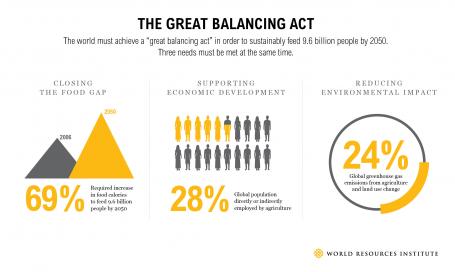Data Visualization
The Great Balancing Act: 3 Needs For A Sustainable Food Future

How can the world feed more than 9 billion people by 2050 in a manner that advances economic development and reduces pressure on the environment? This is one of the paramount questions the world faces over the next four decades.
Answering it requires a “great balancing act” of three needs—all of which must be met simultaneously.
Balancing 3 Needs
- The world needs to close the gap between the amount of food available today and the amount required in 2050. According to new WRI analysis, we’ll need about 60 percent more food calories in 2050 than in 2006 if global demand continues on its current trajectory. This gap is in part a function of increasing population and wealth. The United Nations projects that the global population will likely grow from 7 billion in 2012 to 9.3 billion by 2050. At least 3 billion more people are likely to enter the global middle class by 2030, and they will almost certainly demand more resource-intensive foods like meat and vegetable oils. At the same time, approximately 870 million of the world's poorest people remain undernourished even today.
- The world needs agriculture to contribute to inclusive economic and social development. Agriculture employs more than 2 billion people around the world—more than 28 percent of the global population. And according to the World Bank, growth in the agricultural sector can reduce poverty more effectively than growth arising from other economic sectors. We need a strong agricultural sector if the world is to develop in a way that reduces poverty, alleviates hunger, generates revenue and jobs, and benefits women.
- The world needs to reduce agriculture’s impact on the environment. For instance, agriculture was responsible for approximately 24 percent of global greenhouse gas emissions in 2010 and therefore contributes to climate change. Agriculture is the dominant driver of tropical deforestation. Furthermore, agriculture accounts for about 70 percent of all the freshwater withdrawn from rivers, lakes, and aquifers.